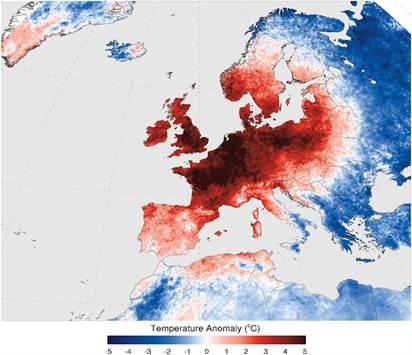The Glasgow Climate Agenda: Global Warming to 2⁰C and Beyond

All Global Research articles can be read in 51 languages by activating the “Translate Website” drop down menu on the top banner of our home page (Desktop version).
Visit and follow us on Instagram at @crg_globalresearch.
***
“Burning all fossil fuels would create a different planet” (Hansen, 2016)
While at present the world is necessarily investing in medical research in order to save the lives of millions, global warming is threatening the lives of billions over the century. Yet, authorities are hardly listening to what climate science is projecting regarding the lives of billions, as the Earth is heating.
Since the Paris climate conference in April 2016, when the mean atmospheric carbon dioxide level reached 403.3 ppm, induced by annual emissions of some 400 billion tons of CO₂, the atmospheric level has risen to near 420 ppm, growing at peak rates of 2.5-3.0 ppm/year, the highest recorded since the dinosaur mass extinction of 66 million years ago.
Although the target of the Glasgow meeting is to reach agreement for limiting mean global temperature to 1.5⁰C, due to the short-term mitigating effect of ~0.5–1.0⁰C by aerosols on global temperatures mean global warming is already tracking toward 2⁰C (Figure 1).
Figure 1. Extreme heatwaves, like the one that affected Europe in the summer of 2006, are projected to become widespread at 1.5 degrees Celsius warming. This map, derived from NASA MODIS Terra satellite data, depicts the July 2006 land surface temperature anomaly with regard to the period from 2000-2012.
Hopes that the coming Glasgow climate meeting would help avert a disastrous climate catastrophe depend on:
- Binding agreements for a drastic reduction of greenhouse gas emissions rates to pre-peak rates of about ~1ppm/year or lower, requiring world-wide transformation of agricultural, industrial and transport systems.
- Attempts at sequestration/drawdown of CO₂ to near-350 ppm or lower (Hansen et al. 2013). Although the engineering efforts and the costs of such attempts cannot be overestimated, in principle such attempts could be achieved by a diversion of funds from the astronomical budgets invested in the military-industrial complex world-wide, currently just under $2 trillion, an underlying factor in previous world wars and ultimately aimed at future wars.
A sequestration of CO₂ is essential due to the amplifying feedbacks of global warming, which is pushing temperatures up in a chain reaction-like process, as follows:
- The polar albedo decline due to large-scale lateral and vertical melting of ice;
- Reduced CO₂ intake by the warming oceans. Currently the oceans absorb between 35-42 percent of all CO₂ emitted into the atmosphere and around 90 percent of the excess heat from the rise in greenhouse gases;
- Warming, desiccation, deforestation and fires over extensive and areas;
- Release of methane from melting of permafrost and from polar sediments;
- An increase in evaporation, particularly in arid zones, raising atmospheric vapor levels enhance the greenhouse gas effect.
Mean global temperature however do not represent an accurate picture of the effects of global warming. According to NOAA the impacts of climate change haven’t been spread evenly around our planet … the strongest warming is happening in the Arctic during its cool seasons, and in Earth’s mid-latitude regions during the warm season.” (Figure 2).
Figure 2. Global climate changes to 1.5 and 2 degrees Celsius. Temperature change is not uniform across the globe. Projected changes are shown for the average temperature of the annual hottest day (top) and the annual coldest night (bottom) with 1.5 degrees Celsius of global warming (left) and 2 degrees Celsius of global warming (right) compared to pre-industrial levels.
The acceleration of warming due to amplifying feedbacks from land and oceans, envisaged by Wally Broecker and others, leads a climate chain reaction such as is believed to have pertained about 55 million years ago during the Paleocene-Eocene thermal maximum (PETM). Peter Ward and others refer to early examples of mass extinctions triggered by biological processes related to ocean anoxia, acidification, release of methane (CH₄) and hydrogen sulphide (H₂S), and development of “purple” and “green” algae and sulphur bacteria. In a similar sense anthropogenic global warming constitutes a biological process which the originating organism, Homo sapiens, has not to date been able to limit.
The critical factor which drives climate change, namely the atmospheric concentration of greenhouse gases, which rose by near-50% since pre-industrial time, is only rarely mentioned by the media and by politicians. Nor are other quantitative measures of climate change, such as the level of methane and nitrous oxide, which were elevated about 3-fold, being highlighted. While opinions by journalists, politicians, economists and social scientists are widely promulgated, less attention is given to what is indicated by climate science, a reluctance rendering the global response to the looming climate calamity increasingly irrelevant.
Many scientists are reluctant to warn the public of the full implications of global heating for the habitability of Earth. Issuing public warnings Cassandra-like may incur a heavy price, including social and professional isolation, psychological effects and loss of professional position. Many either self-censor or were suppressed or dismissed within institutions. This includes a common reluctance by the media to publish climate articles.
According to John Schellnhuber, Germany’s former chief climate scientist: “The Earth system’s responses to climate change appear to be non-linear… If we venture far beyond the 2 degrees guardrail, towards the 4 degrees line, the risk of crossing tipping points rises sharply”.
According to Hansen (NASA’s former chief climate scientist) et al. (2012)
“Burning all fossil fuels would create a different planet than the one that humanity knows. The palaeoclimate record and ongoing climate change make it clear that the climate system would be pushed beyond tipping points, setting in motion irreversible changes, including ice sheet disintegration with a continually adjusting shoreline, extermination of a substantial fraction of species on the planet, and increasingly devastating regional climate extremes”.
Considering that the last glacial termination (LGT), i.e. the transition from the last ice age to the Holocene, incurred a rise of about 4 to 5 degrees Celsius over a period of about 7.5 kyr (0.00053 to 0.00066⁰C/year), the Anthropocene global warming (~+1.5⁰C in 270 years; 0.0055⁰C/year) is reaching an order of magnitude faster than the LGT within a century or so, constituting a recipe for a global disaster.
*
Note to readers: please click the share buttons above or below. Forward this article to your email lists. Crosspost on your blog site, internet forums. etc.
Dr Andrew Glikson is an Earth and Paleo-climate scientist, Canberra, Australia. He is a frequent contributor to Global Research.




